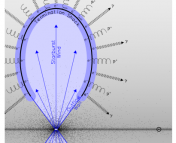Title: The isothermal evolution of a shock-filament interaction
Authors: K. J. A. Goldsmith and J. M. Pittard
First Author’s Institution: School of Physics and Astronomy, University of Leeds, Woodhouse Lane, Leeds LS2 9JT, UK
Status: Open access on arXiv
Galaxies are built from black holes, stars, gas, and dust. While the stars and black holes may get most of the attention, the gas and dust play crucial roles in the evolution of a galaxy. Gas and dust are responsible for forming stars, feeding the central supermassive black hole, and regulating the chemical composition of the galaxy. Consequently, understanding the dynamics of the gas and dust is very important if we want to learn how galaxies work.
One critical mechanism in the workings of galaxies is shocks. Gas in galaxies can frequently become supersonic, such as when a supernova explodes, meaning that it travels faster than the local sound speed. This supersonic gas will generate shocks, just like an airplane traveling supersonically will produce a shockwave in the air that creates a sonic boom. The interactions of these shocks with other shocks or gas features can create turbulence or interesting substructures in the interstellar medium, potentially laying the fertile ground for stars to form.
Today’s paper looks at the interaction of these shocks with filaments of gas. Filaments are long, coherent structures that are found throughout the interstellar medium and that serve as the birthplaces of stars (Figure 1). We know that filaments can be destroyed by shocks, but the exact conditions necessary to destroy a filament remain a mystery. The authors of ran a number of simulations to try to recreate these crime scenes.

How did the authors gather clues? It’s filamentary, my dear Watson.
To investigate this interaction, the authors conducted simulations of a single shock that crashes into a single filament. In order to better understand the physics, they varied multiple properties in the different simulation runs: the speed of the shock, the density of the filament, the orientation of the filament relative to the shock, and the length of the filament. By looking at how the remnants of the filament changed after varying certain parameters, they can gain clues about which parameters really matter for destroying a filament. Plots of one of these simulations are shown in Figure 2, where a filament is oriented sideways, or parallel to, the shock front. This filament is essentially blown up over time, and it develops interesting turbulence in its wake.

The authors found that the filament gas behaved differently when they changed the orientation of the filament relative to the shock, the speed of the shock, and the length and density of the filament. For example, much less turbulence developed when the filament was closer to perpendicular to the shock (Fig 3). Additionally, the filament in Figure 3 was slowly stripped of its material rather than blown up somewhat rapidly like the filament in Figure 2. This means that we could potentially determine the orientation of a filament relative to a shock with only the properties of the remnant gas in the wake.

Verdicts
The authors notice many of these trends among the different properties that they tested. They found:
- Filaments oriented closer to perpendicular to the shock had longer and less turbulent wakes.
- Only sideways-oriented filaments developed a three-rolled structure (see Fig. 2), and filaments with densities different than that of the filament in Figure 2 formed more of a ‘C’ shape.
- Faster shocks stripped material from the filament much more quickly than slower shocks did.
- Longer filaments ended up moving faster than shorter filaments since they were exposed to more of the shock.
- These isothermal simulations were able to push the filaments much faster than in adiabatic simulations.
These results are important for understanding the impact of shocks moving through the interstellar medium. Throughout their journey, they may encounter filaments with various properties. This work will help us to begin to understand what types of shocks are responsible for destroying various types of filaments, bringing us one step closer to solving this ‘shocking’ mystery.





Trackbacks/Pingbacks